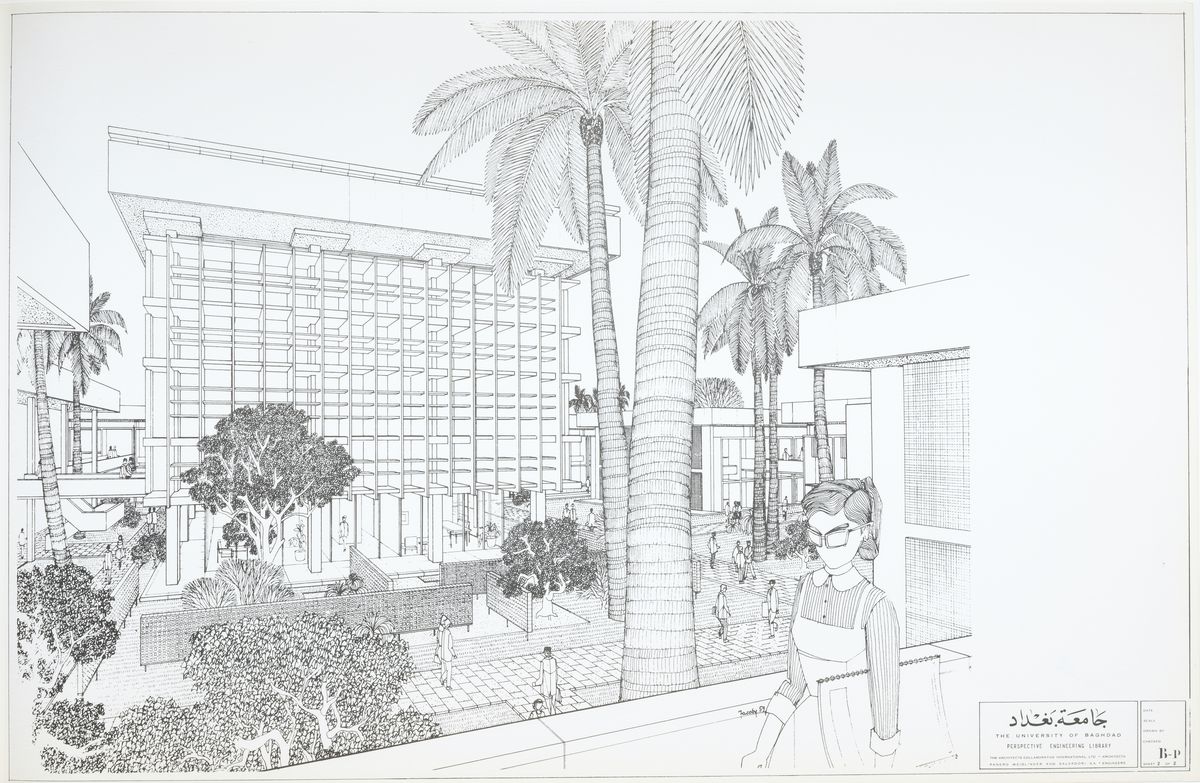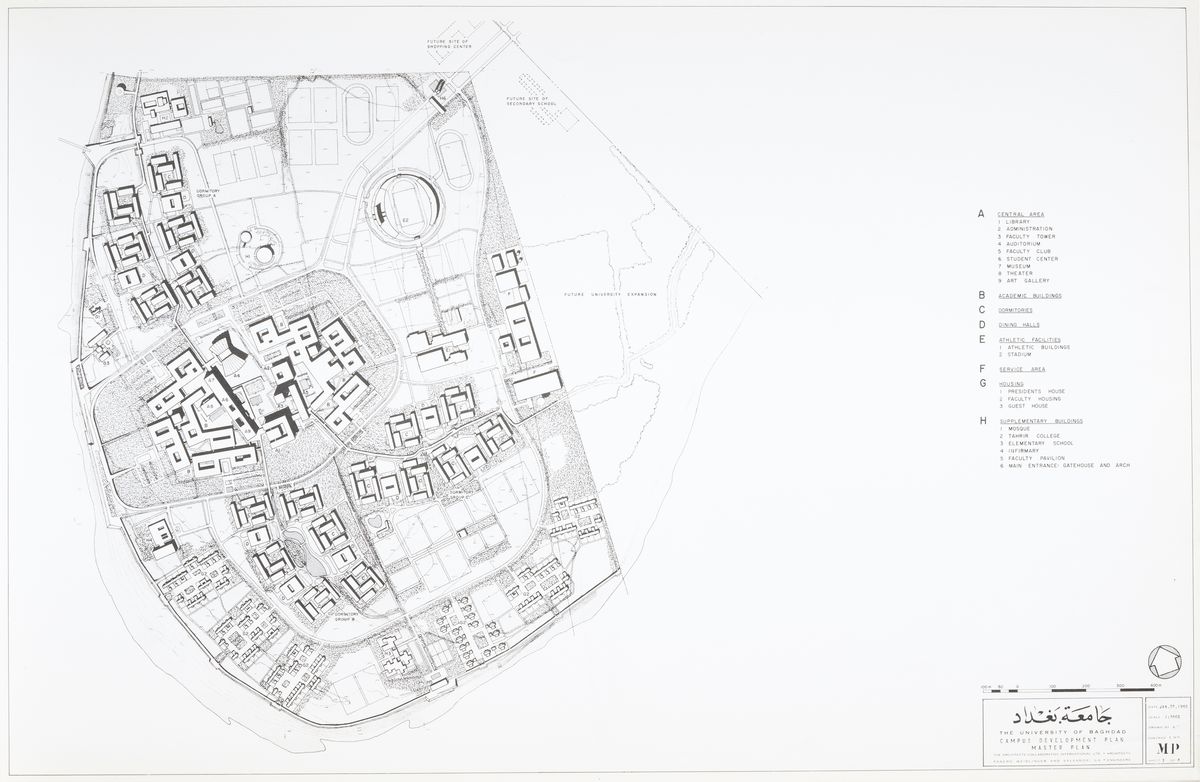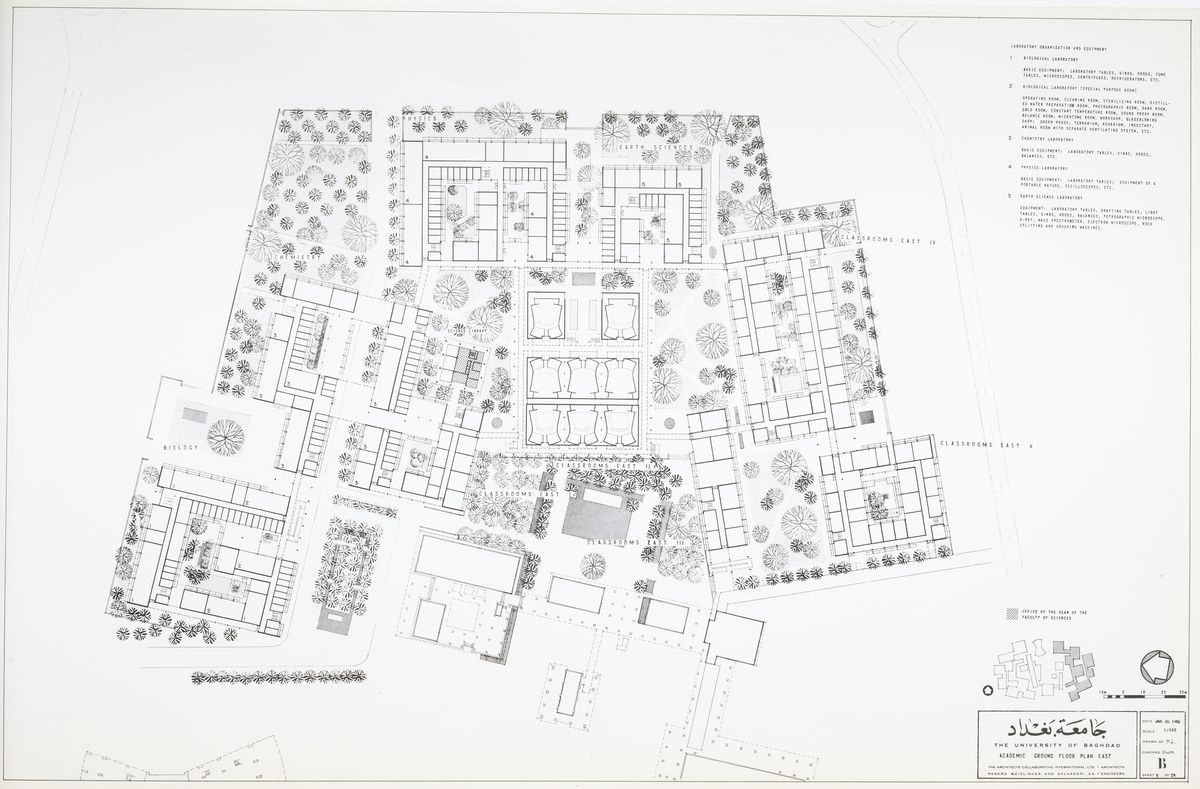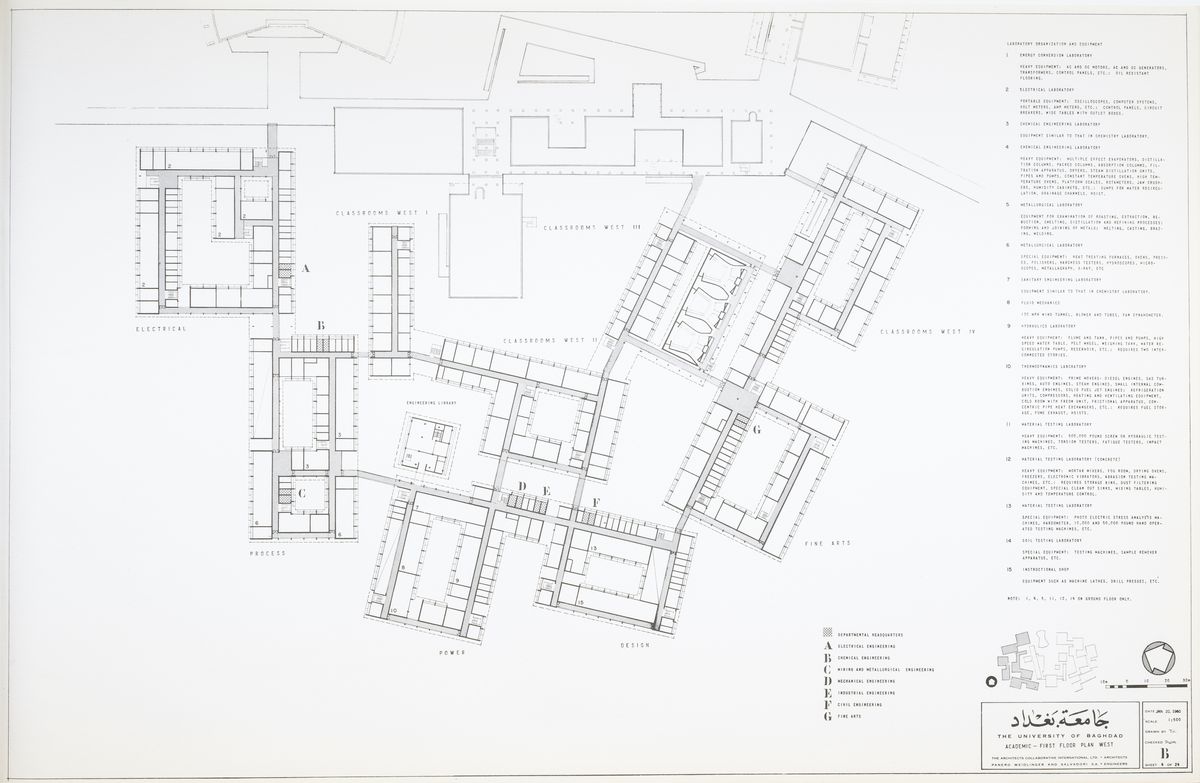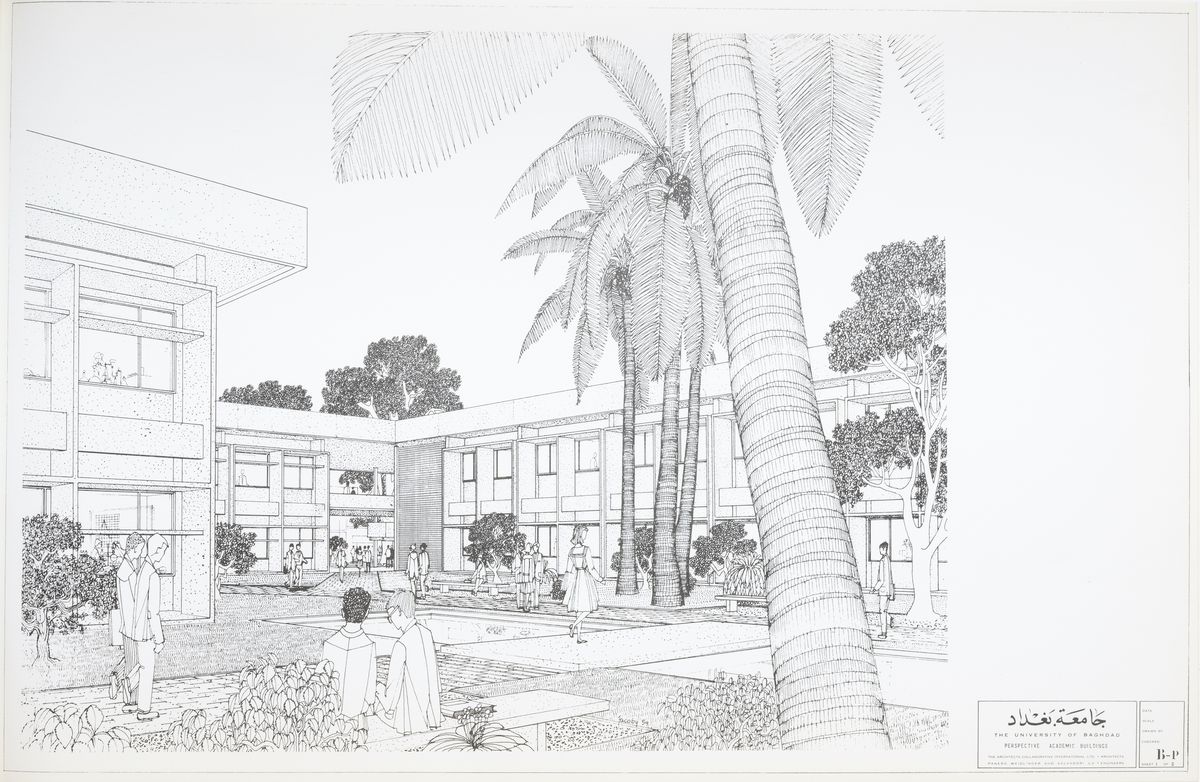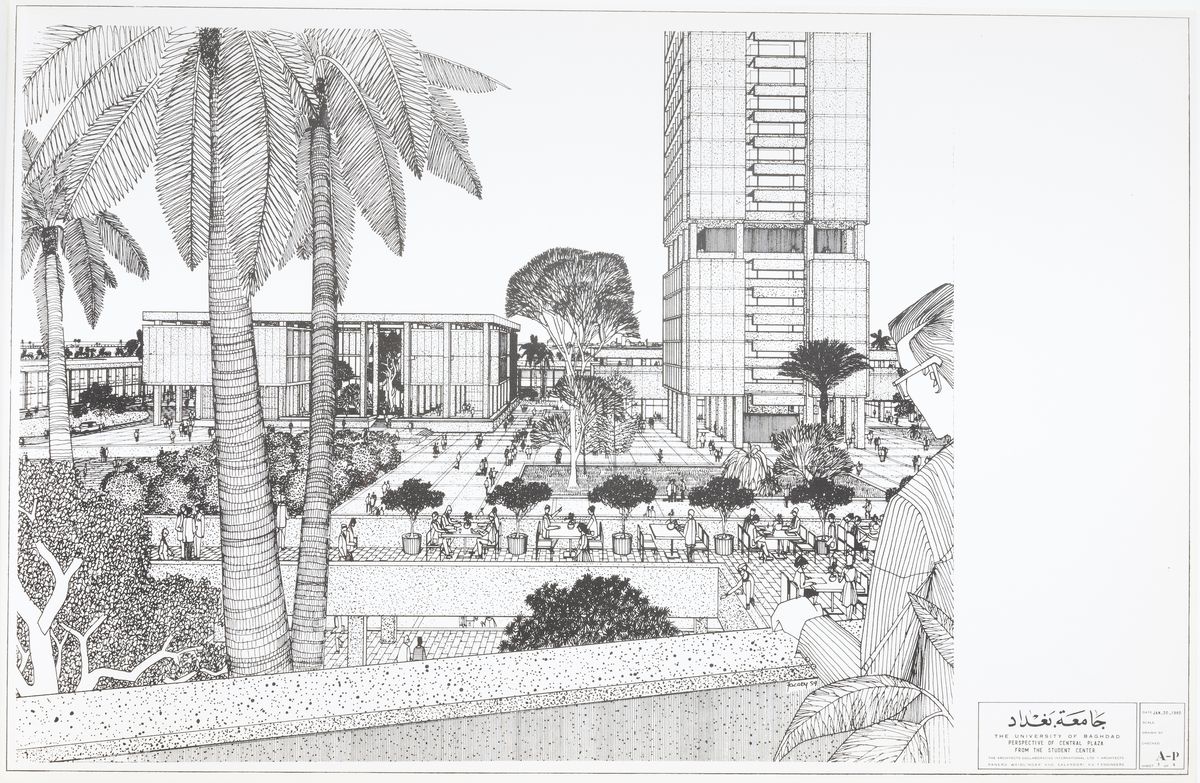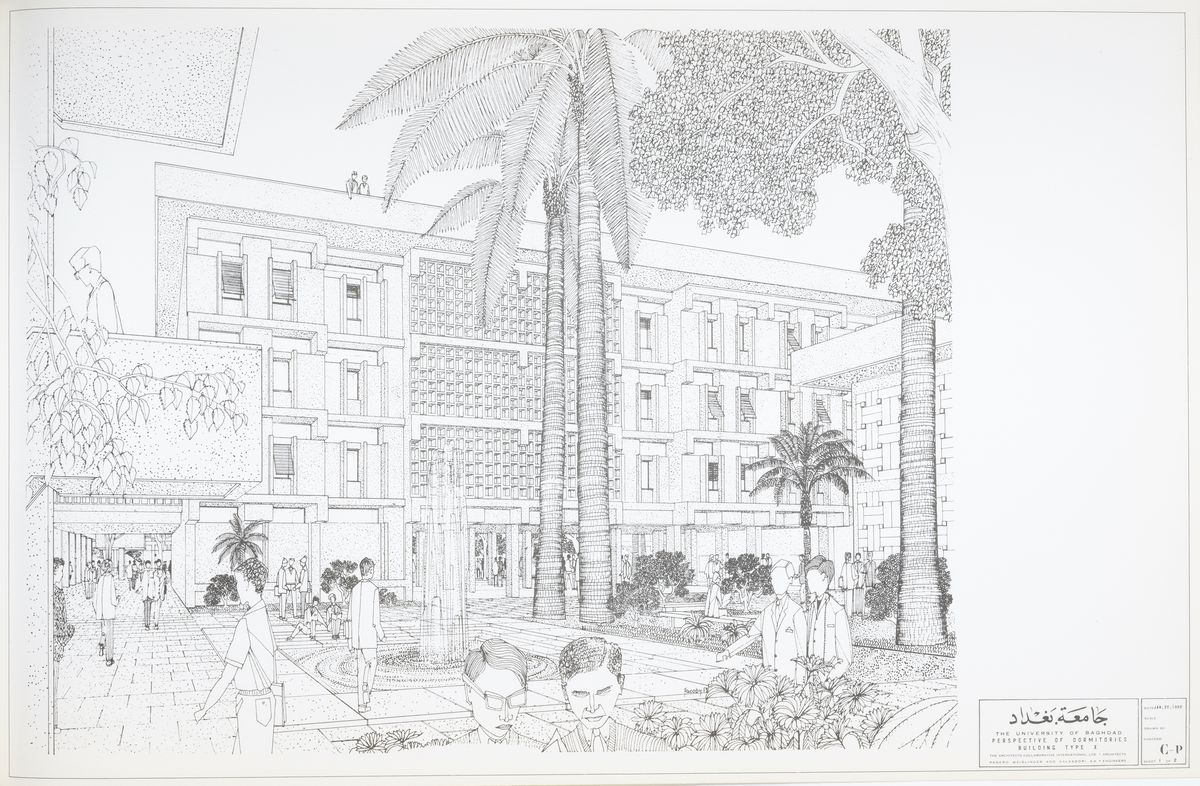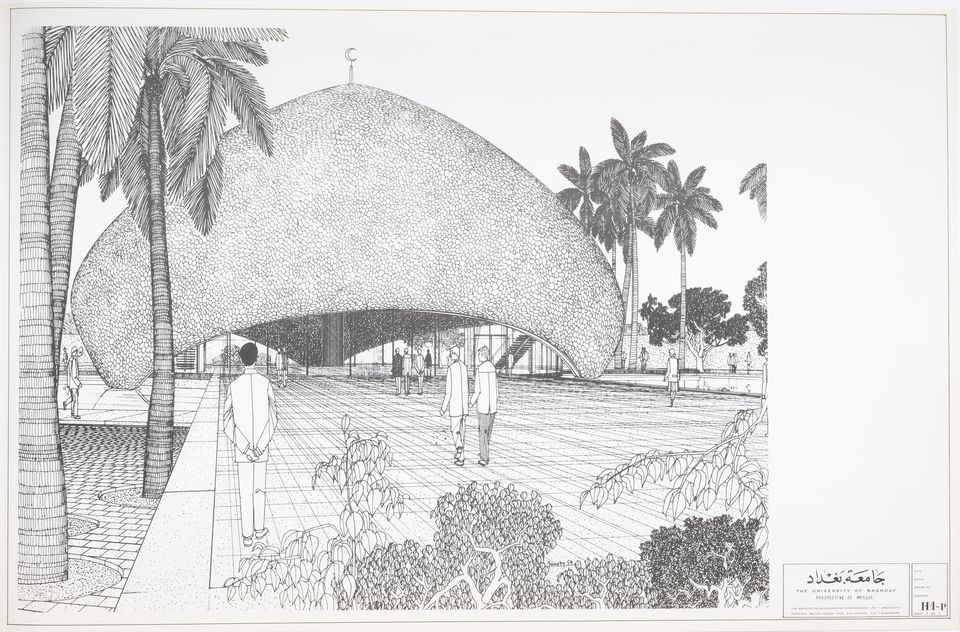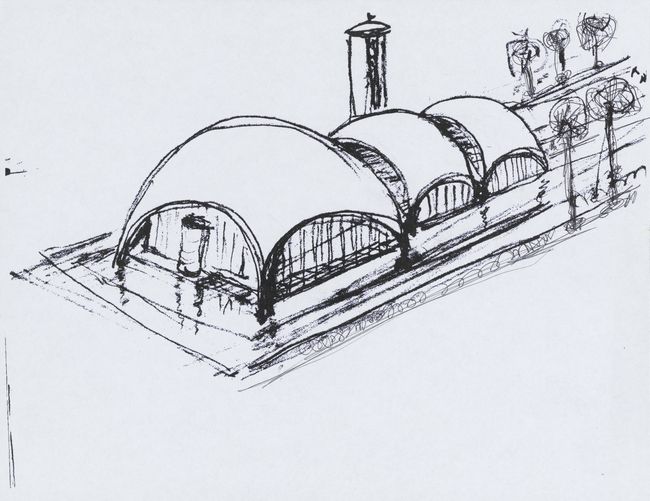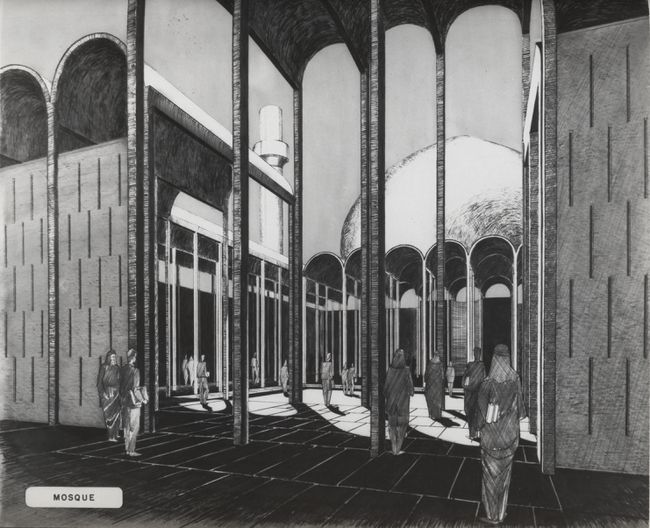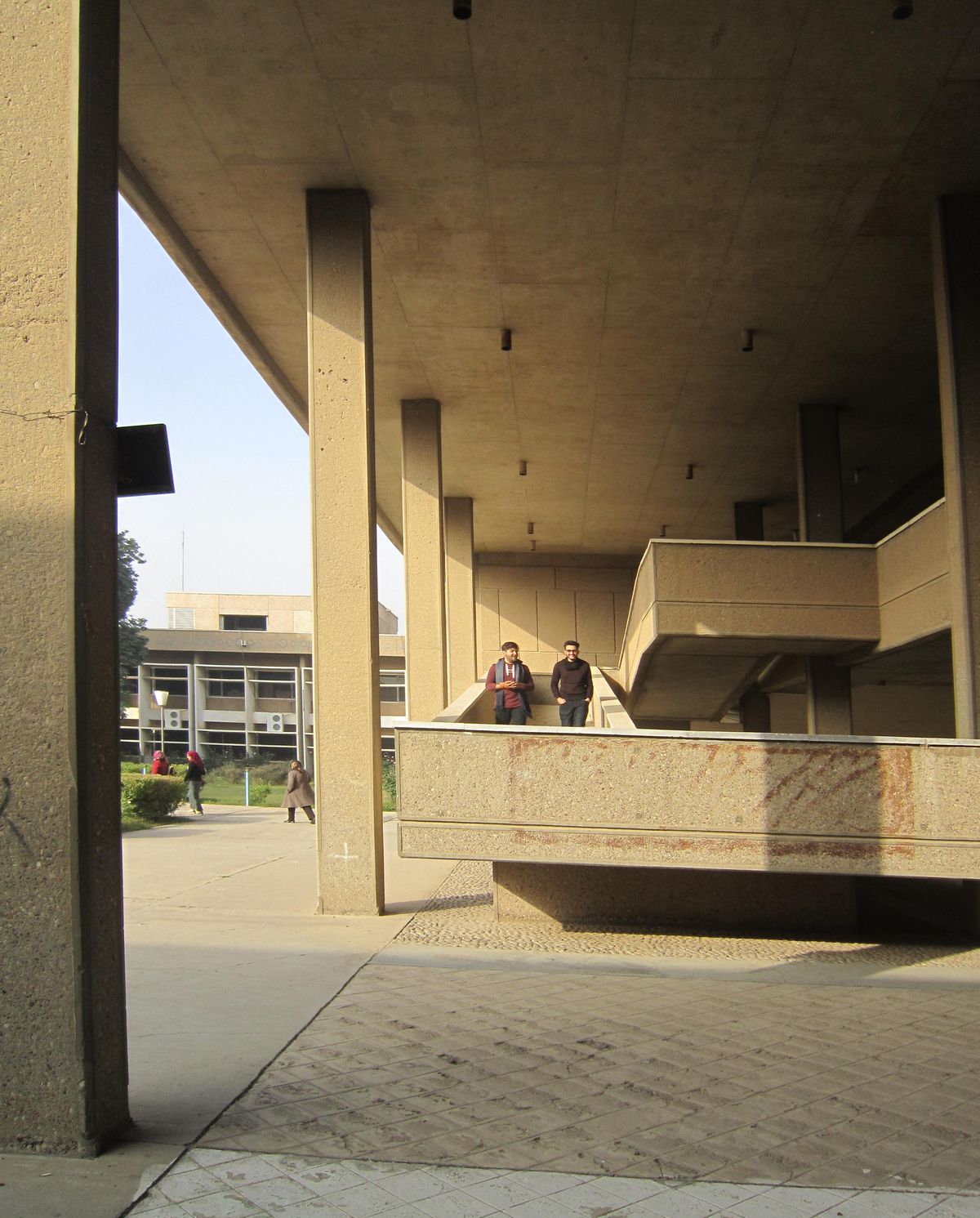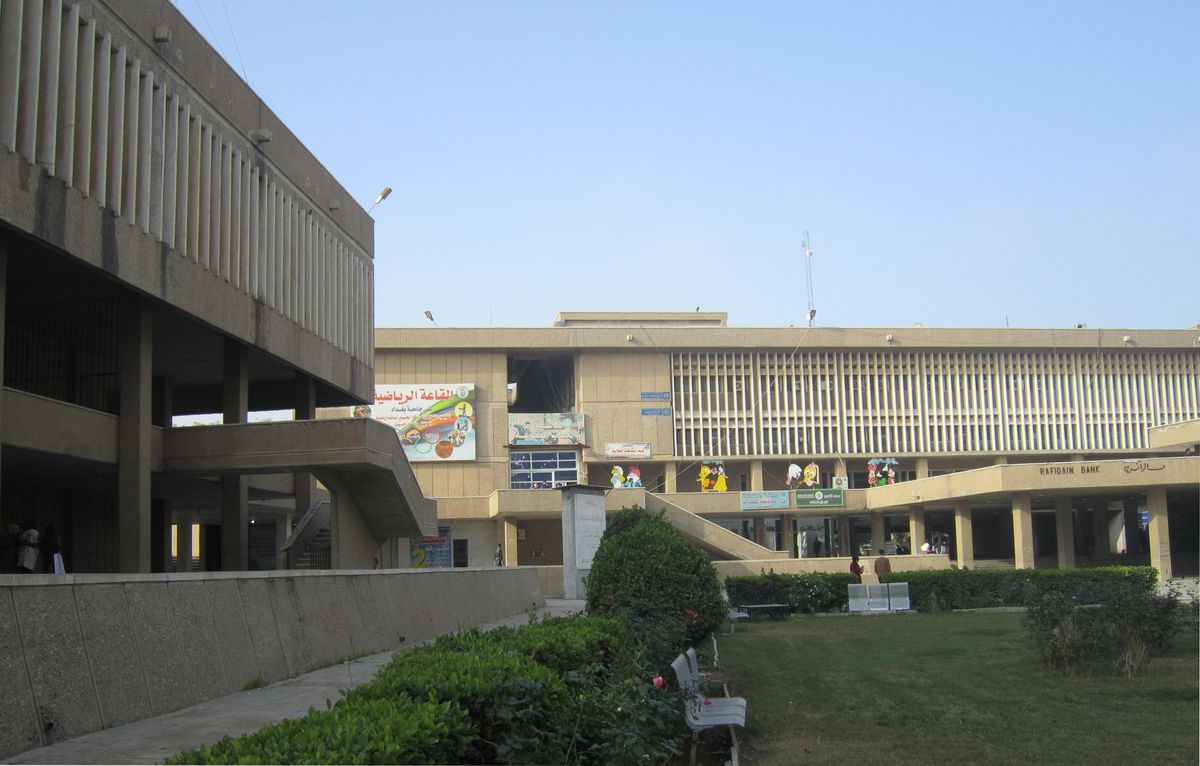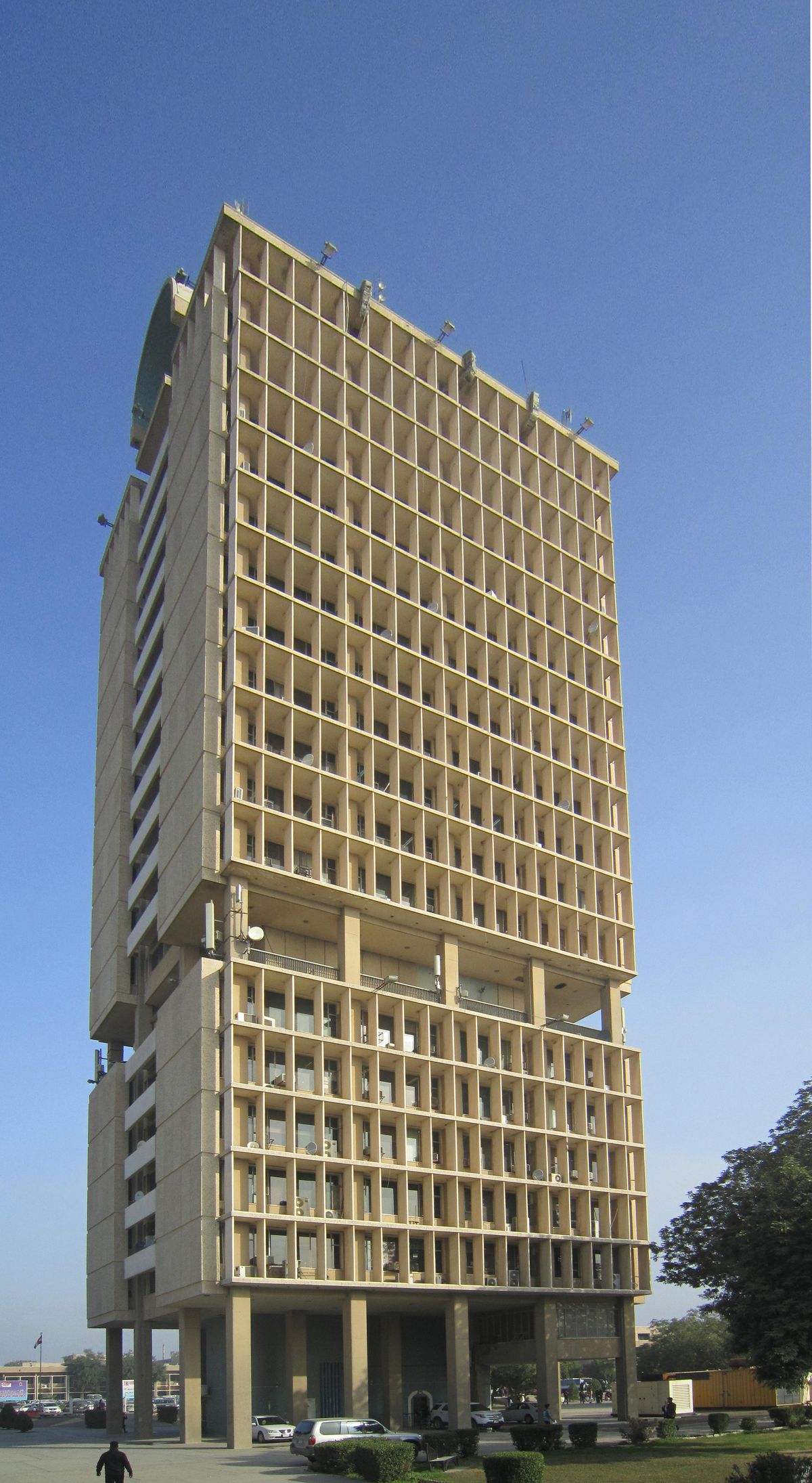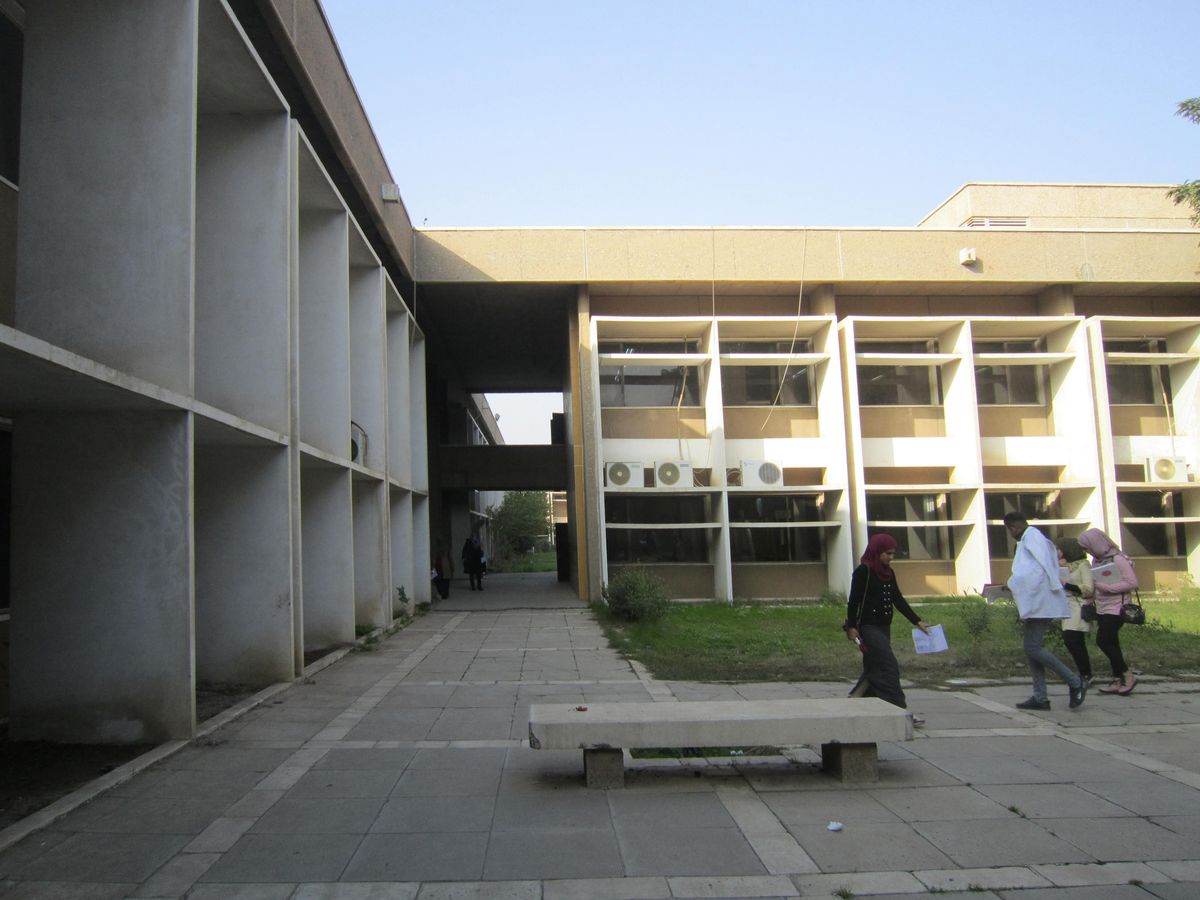A Translation Movement
Esra Akcan on multidirectional exchange in Iraqi modern architecture
By the time Iraq was formed as a country under British mandate after the First World War and the dissolution of the Ottoman Empire, the Ottoman modernization of the late nineteenth century had already made durable marks on its cities. The official mandate used architectural strategies similar to those used in other British colonial cities and employed personnel who had already served the colonization in India.1 Once the 1951 agreement between the Iraqi government and the British headquarters of the Iraq Petroleum Company (until 1929, the Turkish Petroleum Company) diminished British oil profits and increased local revenues, a translation movement in architecture took place, which differed from the mandate period by virtue of the fact that it was a new set of Iraqi elites and the Iraqi government that invited architects. Baghdad thus became a centre of international urbanism as the Iraq Development Board, founded in 1950, invited architects including Constantinos A. Doxiadis, Walter Gropius, Le Corbusier, Frank Lloyd Wright, Josep Lluís Sert, and Gio Ponti to build a modern Baghdad alongside local designers such as Hisham Munir, Rifat Chadirji, Qahtan Awni, and Qahtan Madfai.2
A common narrative about Iraqi modernization is that almost all of the projects that had been assigned to Western European and North American architects in the 1950s were discontinued after the republican revolution of 14 July 1958, which put an end to King Faisal’s monarchy and placed Abdul Karim Qasim in charge of a sovereign Iraq. Archival documents at the CCA about the University of Baghdad and the Baghdad Gymnasium falsify this conclusion.
-
For more discussion, see Esra Akcan, “Democracy and War: University of Baghdad between Collaboration and National Competition,” in Architecture against Democracy: Aesthetics, Nationalism, and Power, eds. Reinhold Martin and Claire Zimmerman (forthcoming). For more on the British mandate and architecture in Baghdad, see Khalid Sultani, “Architecture in Iraq between the Two World Wars, 1920–1940,” Ur: International Magazine of Arab Culture 2–3 (1982): 92–105; and Mark Crinson, Modern Architecture and the End of Empire (Burlington: Ashgate Publishing Company, 2003). ↩
-
On the architecture in Baghdad during this period, see Ihsan Fethi, “Contemporary Architecture in Baghdad: Its Roots and Transition,” in “Medinat al Salaam: Baghdad 1979–83,” ed. Sohiko Yamada, special issue, Process Architecture 58 (1985): 112–132; Hoshiar Nooraddin, “Globalization and the Search for Modern Local Architecture: Learning from Baghdad,” in Planning Middle Eastern Cities: An Urban Kaleidoscope in a Globalizing World, ed. Yasser Elsheshtawy (London: Routledge, 2004), 59–84; Pedro Azara, ed., City of Mirages: Baghdad, from Wright to Venturi (Barcelona: Universitat Politècnica de Catalunya, 2008); Magnus T. Bernhardsson, “Faith in the Future: Nostalgic Nationalism and 1950s Baghdad,” History Compass 9/10 (October 2011): 802–817; Lydia Harrington, “Architecture and Nation-Building in Mid-20th Century Urban Turkey and Iraq” (master’s thesis, University of Washington, 2014); Caecilia Pieri, Baghdad: La construction d’une capitale moderne (1914–1960) (Beyrouth: Damas, 2015); and Ridha Al Chalabi, موسوعة العمارة العراقية [Encyclopedia of Iraqi Architecture], 3 vols. (Baghdad: Ridha Al Chalabi, 2018). ↩
In 1954, Ellen and Nizar Jawdat, architecture students at Harvard University, convinced Nizar’s father, the Iraqi Ambassador in Washington Ali Jawdat Al-Aiyubi, to invite their teacher, Walter Gropius, to undertake the planning of the University of Baghdad. The architectural design, educational policy, and partial implementation of the university was the result of an international collaboration between Gropius, his Boston-based architectural firm TAC (The Architects Collaborative), a large team of professors and experts at Harvard University, and the as-yet uncredited architect and educator Hisham Munir. Three versions of the university were developed between 1954 and 1981, and the project endured three political regimes and six rulers.1 Ellen Jawdat continued to correspond with the architects throughout the process.
A rare portfolio in the CCA’s collection contains the full set of drawings, renderings, and construction details of the second of these schemes, from 1960, which the built project followed closely.2 This scheme was prepared after an intense meeting between the architectural team and Qasim, who had become the new leader after the 1958 revolution, and who requested a few strongly visible design adjustments that would embody the change in regime. Supplementing this portfolio with documents in other archives, we can trace the design process precisely and observe the collaboration that transformed the building complex and gave it both its foreignizing and appropriating translation gestures.3
-
The project was published in Casabella 242 (August 1960). For scholarly accounts of the design of the University of Baghdad, see Gwendolyn Wright, “Global Ambition and Local Knowledge,” in Modernism and the Middle East: Architecture and Politics in the Twentieth Century, eds. Sandy Isenstadt and Kishwar Rizvi (Seattle: University of Washington Press, 2008), 221–254; Mina Marefat, “The Universal University: How Bauhaus Came to Baghdad,” in Azara, City of Mirages, 157–166; Fiona MacCarthy, Gropius: The Man Who Built Bauhaus (Cambridge, MA: Belknap Press, 2019); and Michael Kubo, “‘Companies of Scholars’: The Architects Collaborative, Walter Gropius and the Politics of Expertise at the University of Baghdad,” in Dust and Data: Traces of the Bauhaus across 100 Years, ed. Ines Weizman (Leipzig: Spector Books, 2019), 504–523. ↩
-
Most scholarly articles mention only two rather than three versions. Usually, the 1981 version is not mentioned, despite that scholars seem to look to this version for information about the 1960 version of project. The primary project documents for the University of Baghdad are split between several archives: the Canadian Centre for Architecture; the Walter Gropius Papers, Houghton Library, Harvard University; the Frances Loeb Library, Harvard Graduate School of Design; the MIT Museum Collections; the Harvard Art Museums Archives; and the Hisham Munir Archive, Aga Khan Documentation Center, MIT Libraries. ↩
-
For more discussion and references about these changes, see Akcan, “Democracy and War.” For definitions of foreignizing and appropriating translation, see Esra Akcan, Architecture in Translation: Germany, Turkey, and the Modern House (Durham: Duke University Press, 2012). ↩
Hisman Munir, Thesis for a mosque, 1953, Aga Khan Documentation Center, MIT Libraries © Hisham Munir
Walter Gropius & TAC and Hisham Munir, Second design of the mosque at the University of Baghdad, 1960. In The Architects Collaborative, Report on the University of Baghdad (Cambridge, MA: TAC, 1957). LG338.B33 R47x, Special Collections Rare Oversize, Frances Loeb Library, Harvard Graduate School of Design. Courtesy of the Frances Loeb Library, Harvard Graduate School of Design.
As the CCA portfolio illustrates, the 1960 plan divides the University of Baghdad campus into common, academic, and residential zones, arranged centrifugally, with buildings getting gradually more compact as they extend from the centre towards the surrounding Tigris River. Shared structures, such as the central administration and library buildings, are collected at the core of the first ring, on a central plaza with outward vistas. The departments at the inner periphery of the ring are collected around relatively smaller but civic-scaled green courtyards with fewer vistas. Elevated streets and shaded paths create a continuous web of circulation that knits learning spaces together. Though each department has its own headquarters, in the plan, they share infrastructural facilities, classrooms for 20, 40, 80 and 200 students, and even some labs to foster interdisciplinary dialogue. In the second ring, mid-rise, gender-specific dormitories (originally planned for a capacity of 5,600 men and 2,400 women, and later repurposed as educational facilities) inscribe tighter courtyards. The third, unbuilt ring, a compact fabric of low-rise individual houses for the president, faculty, and research fellows, would have been situated on the periphery along the Tigris River. The design team situated these dormitory zones according to the placement of existing dikes, which had been built during the late Ottoman modernization process to regulate the flow of water and prevent flooding. The team also suggested an irrigation network and a sewage treatment system so that bacteriologically safe water could be used for the irrigation of the campus landscape.
Some of these designs, modified from the earlier university plan, were implemented in response to Qasim’s requests after coming to power. Qasim had asked the team to add a tall building in the central plaza so that, according to TAC architect Louis A. McMillen, he could see it from his office miles away, or so that, according to Munir, the public could see that the government was building the country.1 Additionally, in the first scheme, the university’s mosque was placed in the central plaza as one of the common buildings, sharing the urban fabric with other campus buildings. In the 1960 plan, it is shifted out of the first ring to a detached site, where it stands as a free-standing object on a circular platform. The design team’s decision here better reflected the era’s atmosphere of secular nationalism than it did the American Orientalism of Hamilton Gibb, one of the Harvard University experts on Gropius’s team, who treated Islam as the core of all of life in Middle Eastern societies.2 The architectural design of the first scheme’s mosque followed the classical Sunni typology, with an entrance courtyard and a dome placed on top of a square base, whereas the 1960 version is a uniquely shaped concrete shell dome placed directly on the ground. A mosque design by Munir composed of three shell domes rising directly from ground as a way of integrating new technology and materials served as a reference point in this change. That Munir’s project inspired TAC to change “their traditional mosque into a new form,” made for, as Munir describes, “one of the greatest moments of his career.”3 Munir, who lived in Baghdad through the entire process, ensured the continuity and quality of construction despite periodic halts.
-
Note that the two architects’ different recollections show a distinct division in their respective readings of the motivations behind the project. Louis A. McMillen, “Notes for Gropius Book” (unpublished manuscript, 1989), n.p.; Hisham Munir, “When Politics and Architecture Collide” (lecture at MIT, Cambridge, MA,15 October 2015). ↩
-
For more on the discussion of Orientalism in design, see Akcan, “Democracy and War.” ↩
-
Hashim Munir, manuscript explaining “Thesis: Mosque 1953,” Hashim Munir Archive, Aga Khan Documentation Center, MIT Libraries. ↩
The University of Baghdad is composed of free-standing clusters with ample green spaces between buildings, which, at first sight, might look different from the dense and tight urban fabric of traditional Baghdad. Its exposed-concrete buildings, extended with modular facades, recall the aesthetics of industrialization. But the campus plan is not the result of a foreignizing translation. On the contrary, through the collaboration of architects like Munir and Ellen Jawdat, the University of Baghdad became a site for the invention of a new mid-century modern vocabulary, with sun-protected surfaces and outdoor spaces, covered walkways that maximize shaded surfaces underneath, sun breakers, courtyards, umbrella roofs, wind channels, and breezing tunnels. The design team put particular emphasis on passive climate-control techniques, which they learned by looking at traditional building methods.1 As work proceeded from arranging the site plan to the design of specific buildings, the team’s vocabulary shifted, and references to “old Baghdad houses” increased. At the time, while the Iraqi scholar Ihsan Fethi’s extensive studies on traditional building were becoming public,2 local architects with modernist sensibilities experimented with sun-protected facades; Ihsan Kamil’s sun-shading honeycomb facade at the Khan Pasha residence (1957) is one such example. While inventing their modern climate-control techniques, Gropius and TAC studied as-found versions of traditional houses, spoke to Iraqi colleagues and associate architects, and observed new buildings by local architects. A precise tracing of the planning process demonstrates that the invention of a new mid-century modernist vocabulary, which is usually credited to “great modernist masters,” such as Gropius, Le Corbusier, Sert, and Oscar Niemeyer, was actually the result of a multi-directional and multi-national translation process with many agents.3
-
This aspect is emphasized in all publications and memoirs of the project in addition to the design team’s own reports. John Harkness, The Walter Gropius Archive. Vol 4: 1945–1969. The Work of The Architects Collaborative (New York: Garland Publishing Inc., 1991); The Architects Collaborative, “University of Baghdad,” Architectural Record, April 1959, 147–154; Giulio Carlo Argan, “Walter Gropius and the Design of the University of Baghdad, Iraq” (unpublished manuscript, 1960). The team’s 1957 report also references Doxiadis’s study of low-cost housing for Iraq. ↩
-
Ihsan Fethi, “Urban Conservation in Iraq,” 3 vols. (PhD thesis, University of Sheffield, 1977). ↩
-
For more on this multi-directionality, see Akcan, “Democracy and War.” ↩
This text is an excerpt from Abolish Human Bans: Intertwined Histories of Architecture, a book resulting from Esra Akcan’s participation in the CCA’s Research Fellowship Program.
